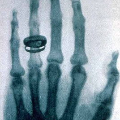Medical image arbitrary-scale super-resolution (MIASSR) has recently gained widespread attention, aiming to super sample medical volumes at arbitrary scales via a single model. However, existing MIASSR methods face two major limitations: (i) reliance on high-resolution (HR) volumes and (ii) limited generalization ability, which restricts their application in various scenarios. To overcome these limitations, we propose Cube-based Neural Radiance Field (CuNeRF), a zero-shot MIASSR framework that can yield medical images at arbitrary scales and viewpoints in a continuous domain. Unlike existing MIASSR methods that fit the mapping between low-resolution (LR) and HR volumes, CuNeRF focuses on building a coordinate-intensity continuous representation from LR volumes without the need for HR references. This is achieved by the proposed differentiable modules: including cube-based sampling, isotropic volume rendering, and cube-based hierarchical rendering. Through extensive experiments on magnetic resource imaging (MRI) and computed tomography (CT) modalities, we demonstrate that CuNeRF outperforms state-of-the-art MIASSR methods. CuNeRF yields better visual verisimilitude and reduces aliasing artifacts at various upsampling factors. Moreover, our CuNeRF does not need any LR-HR training pairs, which is more flexible and easier to be used than others. Our code will be publicly available soon.
翻译:近年来,医学图像任意尺度超分辨率(MIASSR)受到了广泛关注,旨在通过单一的模型对医学数据进行任意比例的上采样。然而,现有的MIASSR方法存在两个主要限制:(i)依赖高分辨率(HR)数据,(ii)泛化能力有限,这限制了它们在各种情况下的应用。为了克服这些限制,我们提出了基于立方块神经辐射场(CuNeRF)的零样本MIASSR框架,它可以在连续领域内产生任意比例和任意视角的医学图像。与现有的MIASSR方法通过匹配低分辨率(LR)和高分辨率(HR)数据不同,CuNeRF注重通过立方块采样、各向同性体积渲染和立方块层次渲染等不同iable模块来建立LR数据的坐标-强度连续表示。通过对磁共振成像(MRI)和计算机断层扫描(CT)进行大量实验,我们证明了CuNeRF优于现有的MIASSR方法。CuNeRF在各种上采样因子下具有更好的视觉真实性并减少了更多的混淆伪影。此外,CuNeRF无需任何LR-HR训练对,更加灵活易用。我们的代码将很快公开。

